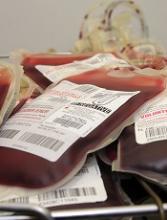MADRID—Results of a phase 2 study have shown that luspatercept can produce sustained increases in hemoglobin and reductions in transfusion burden in adults with β-thalassemia.
Some patients are still receiving the drug and experiencing clinical benefits beyond 24 months.
Luspatercept has been well-tolerated in these patients, producing no serious adverse events (AEs).
“Luspatercept has many characteristics that are promising . . .,” said Antonio G. Piga, MD, of Turin University in Turin, Italy.
He presented results of the phase 2 study at the 22nd Congress of the European Hematology Association (EHA) as abstract S129.
The study was sponsored by Celgene in collaboration with Acceleron Pharma.
Dr Piga presented data on 63 patients—32 of whom were transfusion-dependent (TD) and 31 of whom were non-transfusion-dependent (NTD).
For the entire study cohort, the median age was 38 (range, 20-62), 52% of patients were male, and 67% had undergone a splenectomy.
In the NTD patients, the median hemoglobin at baseline was 8.5 g/dL (range, 6.5-9.8).
The TD patients received a median of 8 (range, 4-18) red blood cell (RBC) units every 12 weeks.
For the 3-month base study, patients received luspatercept at 0.2 mg/kg to 1.25 mg/kg every 3 weeks.
In the ongoing extension study, patients can receive luspatercept at 0.8 mg/kg to 1.25 mg/kg every 3 weeks for up to 5 years.
Efficacy in NTD patients
The median duration of treatment for NTD patients (n=31) was 18.6 months (range, 1.3-29.4 months; ongoing).
Over a 12-week period, 71% (22/31) of NTD patients saw at least a 1.0 g/dL increase in mean hemoglobin from baseline. Fifty-two percent (16/31) saw an increase of 1.5 g/dL or greater.
To assess quality of life in NTD patients, the researchers used FACIT-F, a 13-item questionnaire used to assess anemia-related symptoms such as fatigue and weakness.
Fifty-eight percent (7/12) of patients with a baseline FACIT-F deficit (<44 points) had improved by at least 3 points at 48 weeks.
And 86% (6/7) of patients with at least a 3-point increase in FACIT-F score had at least a 1.0 g/dL improvement in mean hemoglobin over a 12-week period.
Efficacy in TD patients
The median duration of treatment for TD patients was 14.2 months (range, 0.7-27.2 months, ongoing).
Seventy-eight percent (25/32) of these patients had at least a 20% reduction in RBC units transfused from 12 weeks pre-treatment to any 12-week interval on treatment. Sixty-nine percent (22/32) had at least a 33% reduction at any 12-week interval.
Fifty percent of patients (12/24) who received an estimated 6 to 20 RBC units every 24 weeks achieved a reduction in transfusion burden from baseline of at least 33% in the fixed 12-week interval from weeks 13 to 24.
Forty-six percent (11/24) achieved a reduction in transfusion burden from baseline of at least 33% in the interval from weeks 37 to 48.
Safety
The most common AEs possibly or probably related to luspatercept were bone pain (38%), headache (28%), myalgia (22%), arthralgia (19%), musculoskeletal pain (17%), asthenia (14%), injection site pain (13%), and back pain (11%).
Most AEs were grade 1 or 2 in severity. Treatment-related grade 3 AEs included bone pain (n=3), asthenia (n=2), and headache (n=1).
Dr Piga said these results support an ongoing phase 3 study of luspatercept in regularly transfused patients with β-thalassemia (BELIEVE, NCT02604433), which recently completed enrollment.


